Selecting Check Valves in Large Seawater Desalination Projects
Jul 12, 2023
Reasonable selection of valves for large seawater desalination projects can reduce material consumption, reduce partial resistance and energy consumption, facilitate installation and reduce maintenance. This article focuses on the selection of large-diameter shut-off valves and check valves.
Cut-off valves
The diameter of the process pipe in large-scale seawater desalination is generally DN300 to 1600, which is beyond the scope of use of general ball valves and globe valves. Compared with gate valves (Z41H) with the same diameter, the butterfly valve has the advantages of simple structure, easy corrosion, short installation length, less steel consumption, and similar partial resistance coefficient of the valve. It is more economical and practical to choose the butterfly valve as the shut-off valve. According to the pressure level, butterfly valves can be divided into low-pressure butterfly valves and high-pressure butterfly valves.
(1) Low-pressure butterfly valves
Centerline pinless rubber-lined butterfly valves can be used. When the butterfly valve is less than and equal to DN500, use the wafer connection. When the butterfly valve is greater than and equal to DN550, use flange connection. When the diameter of the butterfly valve is less than and equal to 6 inches (DN150), the opening force is less than 400N, and the handle is used. When the butterfly valve’s diameter is greater than and equal to 8 inches (DN200), it is operated with a gearbox. The center line structure will not increase too much torque due to the low back pressure of the low-pressure valve. This structure has two seals. The main seal is obtained by the pre-tightening force of the butterfly plate and the valve seat, and the second seal is obtained by the interference fit of the valve stem and the valve seat hole. Since the valve stem is completely isolated from the medium and does not seep into seawater, the valve stem can be made of 2Cr13 or equivalent materials. The valve body is lined with EPDM ductile iron to increase the sealing performance. Since the valve body is not in contact with the medium, the requirements for the performance of the valve body material are reduced (Table 3).
(2) High-pressure butterfly valves
When selecting the material for the high-pressure butterfly valve, in addition to considering the corrosion of seawater, the pressure resistance of the material also needs to be considered. When the working pressure is 69 bar and the maximum pressure is greater than and equal to 85 bar, the high-pressure butterfly valve adopts a double eccentric structure to reduce the torque due to high back pressure. When the nominal size of the butterfly valve is less than or equal to DN500, the wafer connection is adopted. When the nominal size of the butterfly valve is greater than and equal to DN550, the flange end is adopted. The pressure is Cl 600, and the valve body and butterfly plate are made from duplex steel ASTM A995 GR. 4A. Since the valve stem is exposed to the medium, the valve stem is made from ASTM A276 UNS31803, and the valve seat RPTFE. The double eccentric structure increases the partial resistance coefficient, the butterfly plate and the valve stem need to be fixed by pins. The requirements for anti-corrosion of the pins are the same as other flow-passing parts.
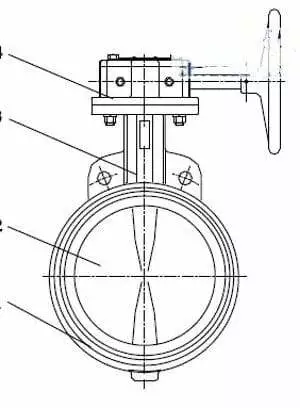
1. Valve bodies 2. Discs 3. Stems 4. Actuators
Figure 1 Low-pressure butterfly valves
Table 3 Materials of main parts of low-pressure center line butterfly valves
Cut-off valves
The diameter of the process pipe in large-scale seawater desalination is generally DN300 to 1600, which is beyond the scope of use of general ball valves and globe valves. Compared with gate valves (Z41H) with the same diameter, the butterfly valve has the advantages of simple structure, easy corrosion, short installation length, less steel consumption, and similar partial resistance coefficient of the valve. It is more economical and practical to choose the butterfly valve as the shut-off valve. According to the pressure level, butterfly valves can be divided into low-pressure butterfly valves and high-pressure butterfly valves.
(1) Low-pressure butterfly valves
Centerline pinless rubber-lined butterfly valves can be used. When the butterfly valve is less than and equal to DN500, use the wafer connection. When the butterfly valve is greater than and equal to DN550, use flange connection. When the diameter of the butterfly valve is less than and equal to 6 inches (DN150), the opening force is less than 400N, and the handle is used. When the butterfly valve’s diameter is greater than and equal to 8 inches (DN200), it is operated with a gearbox. The center line structure will not increase too much torque due to the low back pressure of the low-pressure valve. This structure has two seals. The main seal is obtained by the pre-tightening force of the butterfly plate and the valve seat, and the second seal is obtained by the interference fit of the valve stem and the valve seat hole. Since the valve stem is completely isolated from the medium and does not seep into seawater, the valve stem can be made of 2Cr13 or equivalent materials. The valve body is lined with EPDM ductile iron to increase the sealing performance. Since the valve body is not in contact with the medium, the requirements for the performance of the valve body material are reduced (Table 3).
(2) High-pressure butterfly valves
When selecting the material for the high-pressure butterfly valve, in addition to considering the corrosion of seawater, the pressure resistance of the material also needs to be considered. When the working pressure is 69 bar and the maximum pressure is greater than and equal to 85 bar, the high-pressure butterfly valve adopts a double eccentric structure to reduce the torque due to high back pressure. When the nominal size of the butterfly valve is less than or equal to DN500, the wafer connection is adopted. When the nominal size of the butterfly valve is greater than and equal to DN550, the flange end is adopted. The pressure is Cl 600, and the valve body and butterfly plate are made from duplex steel ASTM A995 GR. 4A. Since the valve stem is exposed to the medium, the valve stem is made from ASTM A276 UNS31803, and the valve seat RPTFE. The double eccentric structure increases the partial resistance coefficient, the butterfly plate and the valve stem need to be fixed by pins. The requirements for anti-corrosion of the pins are the same as other flow-passing parts.

1. Valve bodies 2. Discs 3. Stems 4. Actuators
Figure 1 Low-pressure butterfly valves
Table 3 Materials of main parts of low-pressure center line butterfly valves
| Parts | Materials |
| Valve bodies | Ductile iron outer surface polyester coatings |
| Valve seats | EPDM |
| Butterfly plates | Nickel Aluminum Bronze, Ductile Iron |
| Valves | 2Cr13 or equivalent materials |
| Handles | Cast iron and polyester coatings on the outer surface |
| Gearboxes | Cast iron and polyester coatings on the outer surface |
Please note that when the medium contains abrasive particles, the disc should be made from ASTM A995 GR. 4A or above.
Check valves
Check valves are usually installed at the outlet of seawater pumps to prevent backflow of seawater and damage to equipment caused by water hammer. At present, the check valves used in seawater desalination projects include slow-closing butterfly check valves, fully rubber-lined butterfly wafer check valves, single-disc wafer check valves, and single-disc dual-phase steel wafer check valves.
(1) Slow-closing butterfly check valves
The main material of the slow-closing butterfly check valve is nodular cast iron. The mechanical or hydraulic slow-closing ability is better against water hammer, and it is suitable for low pressure. After investigation, it is found that it is currently widely used in wastewater treatment, chemical plants, municipal, and the product hydraulic section of seawater desalination projects.
(2) Fully lined butterfly wafer check valves
The fully rubber-lined butterfly check valve has an improvement in anti-corrosion. The valve body and stem are fully rubber-lined, and the disc can be made from duplex stainless steel or nickel aluminum bronze. This type of valve is set at the outlet of the low-pressure seawater pump and is suitable for installation on large-diameter pipelines. The nominal diameter of the valve ranges from DN200 to 1200. Attention should be paid to the requirements of installation space of the valve during design. Improper installation of the valve will cause the valve disc and spring to act on the valve stem for a long time, destroying the seal between the valve body and the valve stem, infiltrating the medium, causing corrosion of the valve body and shortening the service life of the valve.
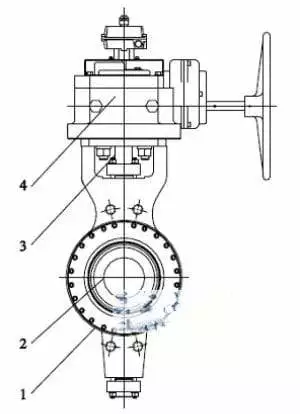
1. Valve bodies 2. Discs 3. Stems 4. Actuators
Figure 2 Double eccentric high-performance butterfly valves
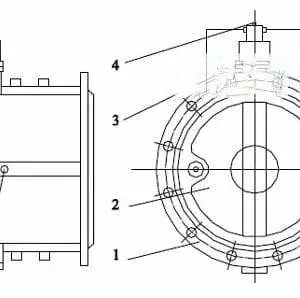
1. Valve bodies 2. Discs 3. Oil storage cylinders 4. Fine-tuning valves
Figure 3 Slow closing butterfly check valves

1. Valve bodies 2. Discs 3 Valve stems
Figure 4 Full rubber lined butterfly wafer check valves H77X - 10Q
(3) Single disc wafer check valves
The single disc wafer check valve has a simple structure and small installation space, and can be used under low pressure or high pressure. The valve is made from duplex stainless steel, which has good seawater corrosion resistance, light weight, can be installed horizontally and vertically, and is easy to use. In the seawater desalination device, the single disc check valve with a diameter less than and equal to DN250 is generally used. When the nominal size of the valve is greater than DN250, the water hammer effect is obvious and the action noise is great. Large-diameter single disc wafer check valves are widely used in gas piping. The valve has a non-full bore, with a disc opening of up to 45°, an increase in the resistance coefficient and a decrease in flow capacity.
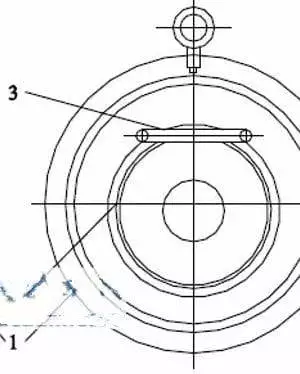
1. Valve bodies 2. Discs 3. Stems
Figure 5 Single disc wafer check valves
(4) Single disc dual phase steel wafer check valves
The single-disc dual-phase steel wafer check valve has a small installation space. It adopts INCONEL springs to cooperate with the disc gravity to quickly close. When the flow or pressure is lower than a certain value, it will automatically close and resist water hammer. The sealing surface adopts an EPDM sealing ring to reduce the effect of water hammer. The streamlined disc has a low local resistance coefficient, and the valve opening increases. The single-disc dual-phase steel wafer check valve is installed at the outlet of the reverse osmosis high-pressure pump for seawater desalination. It is a solution for high pressure, anti-water hammer, corrosion resistance and non-return.
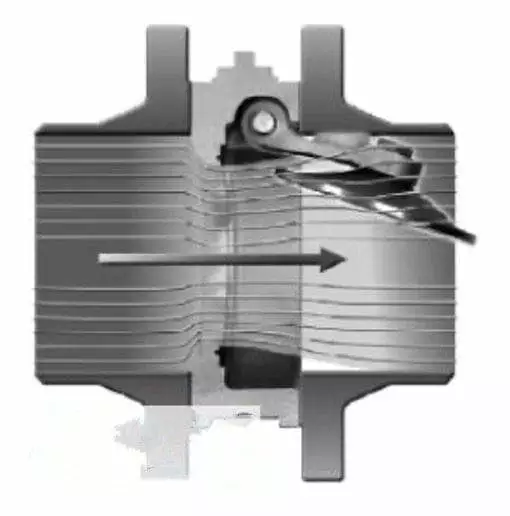
Figure 6 Single disc dual phase steel wafer check valves
Previous: Five Ways to Resist Corrosion of Valves
Next: Structural Principle and Performance of Double Plate Butterfly Check Valves


